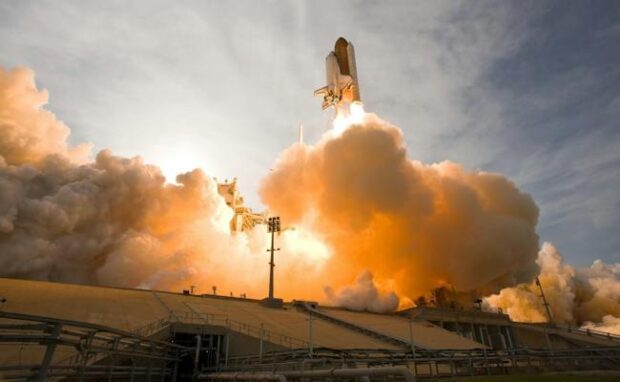Space rocket “eats” its body for fuel
University of Glasgow researchers created a space rocket that consumes its body to propel itself into space. They named it the Ouroboros-3, and its plastic fuel tubing melts and adds to the propulsion as the rocket continues its burn. As a result, the Scottish scientists hope this new rocket design could reduce space junk from future space missions.
Space agencies and other experts have been finding ways to solve space junk. After years of space exploration, we’ve left so much debris in the Earth’s orbit. Nowadays, that garbage endangers active satellites and obstructs future space missions. This new rocket design could be a way to minimize space trash so that humanity can continue traversing space.
This article will discuss how the Ouroboros0-3 space rocket functions. Later, I will share other rocket innovations that make space missions more sustainable than ever.
How does this space rocket work?
Like other rockets, the Ouroboros-3 uses gaseous oxygen and liquid propane as the main propellant for initial ignition. Eventually, its high-density polyethylene plastic tubing encasement prolongs propulsion as the rocket burns.
PopSci compares it to a candlestick flame burning wax. Its unique case provides a fifth of the required amount of propellant. Also, the experimental rocket generated as much as 100 newtons of thrust.
“These results are a foundational step on the way to developing a fully functional autophagy rocket engine,” University of Glasgow Professor Patrick Harkness states. The word “autophage” means “self-eating” in Latin.
Ouroboros is the name of the mythical Egyptian snake that eats its tail. “Those future rockets could have a wide range of applications which would help advance the UK’s ambitions to develop as a key player in the space industry.”
“A conventional rocket’s structure makes up between five and 12 percent of its total mass. Our tests show that the Ouroborous-3 can burn a very similar amount of its own structural mass as a propellant,” Harkness adds.
You may also like: Scientists turn flies into biodegradable plastic
“If we could make at least some of that mass available for payload instead, it would be a compelling prospect for future rocket designs,” the professor believes.
“Getting to this stage involved overcoming a lot of technical challenges, but we’re delighted by the performance of the Ouroboros-3 in the lab,” postgraduate researcher Krzysztof Bzdyk told University of Glasgow News.
“If we could make at least some of that mass available for payload instead, it would be a compelling prospect for future rocket designs,” he said. “From here, we’ll begin to look at how we can scale up autophage propulsion systems to support the additional thrust required to make the design function as a rocket.
Other rocket innovations

We are also developing rockets that run on cow dung. Japan-based space tech company Interstellar Technologies successfully tested one last year.
IST started by working with the Air Water Group to gather biogas from local farmers. They turned livestock manure into liquid biomethane (LBM).
Aside from this fuel, the ZERO launch vehicle rocket uses liquid methane as a propellant. This combination of renewable energy sources gives the rocket engine low cost, fuel performance, environmental impact, and availability.
You may also like: Plastic waste prevents marine animal reproduction
It uses a two-stage design incorporating a pintle injector, reducing the number of components and improving combustion efficiency. The pintle injector delivers propellants (oxidizer and liquid fuel) into a rocket engine’s combustion chamber in a controlled manner.
“The number of components has been reduced to one-tenth of conventional engines, fundamentally lowering the manufacturing costs of a rocket engine, estimated to constitute half of the overall expenses,” the IST said.
The cow-dung rocket engine reduces Japan’s carbon emissions while providing more space rocket fuel. Its success will contribute to the success of the ZERO launch vehicle rocket’s 2025 launch.
Conclusion
University of Glasgow scientists created a space rocket that consumes its plastic tubing for fuel. As a result, it could reduce the amount of junk space missions leave.
Jack Tufft, a postgraduate researcher at the James Watt School of Engineering, said, “Our aim is to bring the autophage engine closer to a test launch, which will help us develop our design for future generations of autophage rockets.”
Get more details about this self-eating space rocket by reading its Aerospace Research Central study. Check the latest digital tips and trends at Inquirer Tech.